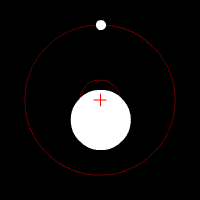Center of mass




Center of mass is a fundamental concept in physics and engineering that represents the mean location of the distribution of mass in a body or system. It is a critical concept in the analysis of motion and is used to predict the behavior of objects in various physical situations, such as when they are subjected to forces or torques. The center of mass is a point where one can consider the entire mass of an object to be concentrated for the purpose of analysis.
Definition[edit]
The center of mass of an object or system of particles is the point at which the weighted relative position of the distributed mass sums to zero. Mathematically, it is defined as the average position of all the points in a body or system, weighted by their mass. For a system of particles, the center of mass is given by the formula:
\[ \mathbf{R}_{\text{cm}} = \frac{1}{M} \sum_{i} m_i \mathbf{r}_i \]
where \( \mathbf{R}_{\text{cm}} \) is the position vector of the center of mass, \( M \) is the total mass of the system, \( m_i \) is the mass of the \(i\)th particle, and \( \mathbf{r}_i \) is the position vector of the \(i\)th particle.
For a continuous distribution of mass, the center of mass is found using the integral form:
\[ \mathbf{R}_{\text{cm}} = \frac{1}{M} \int \mathbf{r} \, dm \]
where \( dm \) represents an infinitesimal element of mass at position \( \mathbf{r} \).
Properties[edit]
The center of mass has several important properties:
- It acts as the point where external forces can be applied to predict the motion of the object without causing rotation, assuming the body is free to move in space.
- In the absence of external forces, the center of mass of a system of particles moves in a straight line with constant velocity.
- The position of the center of mass is independent of the reference frame, meaning it is the same in all inertial frames.
Applications[edit]
The concept of the center of mass is widely used across various fields:
- In mechanics, it is used to analyze the motion of objects, including their translation and rotation around the center of mass.
- In astronomy, it helps in understanding the orbits of planets and stars, as they revolve around their common center of mass.
- In sports and human biomechanics, it is crucial for analyzing the balance and movements of athletes.
- In engineering, it is used in the design of structures, vehicles, and machinery to ensure stability and proper functioning.
Calculation[edit]
The calculation of the center of mass depends on the symmetry and density of the object. For simple geometric shapes with uniform density, the center of mass can often be determined from symmetry alone. For more complex shapes or density distributions, analytical or numerical methods may be required.
See Also[edit]
Ad. Transform your life with W8MD's Budget GLP-1 injections from $75


W8MD offers a medical weight loss program to lose weight in Philadelphia. Our physician-supervised medical weight loss provides:
- Weight loss injections in NYC (generic and brand names):
- Zepbound / Mounjaro, Wegovy / Ozempic, Saxenda
- Most insurances accepted or discounted self-pay rates. We will obtain insurance prior authorizations if needed.
- Generic GLP1 weight loss injections from $75 for the starting dose.
- Also offer prescription weight loss medications including Phentermine, Qsymia, Diethylpropion, Contrave etc.
NYC weight loss doctor appointmentsNYC weight loss doctor appointments
Start your NYC weight loss journey today at our NYC medical weight loss and Philadelphia medical weight loss clinics.
- Call 718-946-5500 to lose weight in NYC or for medical weight loss in Philadelphia 215-676-2334.
- Tags:NYC medical weight loss, Philadelphia lose weight Zepbound NYC, Budget GLP1 weight loss injections, Wegovy Philadelphia, Wegovy NYC, Philadelphia medical weight loss, Brookly weight loss and Wegovy NYC
|
WikiMD's Wellness Encyclopedia |
| Let Food Be Thy Medicine Medicine Thy Food - Hippocrates |
Medical Disclaimer: WikiMD is not a substitute for professional medical advice. The information on WikiMD is provided as an information resource only, may be incorrect, outdated or misleading, and is not to be used or relied on for any diagnostic or treatment purposes. Please consult your health care provider before making any healthcare decisions or for guidance about a specific medical condition. WikiMD expressly disclaims responsibility, and shall have no liability, for any damages, loss, injury, or liability whatsoever suffered as a result of your reliance on the information contained in this site. By visiting this site you agree to the foregoing terms and conditions, which may from time to time be changed or supplemented by WikiMD. If you do not agree to the foregoing terms and conditions, you should not enter or use this site. See full disclaimer.
Credits:Most images are courtesy of Wikimedia commons, and templates, categories Wikipedia, licensed under CC BY SA or similar.
Translate this page: - East Asian
中文,
日本,
한국어,
South Asian
हिन्दी,
தமிழ்,
తెలుగు,
Urdu,
ಕನ್ನಡ,
Southeast Asian
Indonesian,
Vietnamese,
Thai,
မြန်မာဘာသာ,
বাংলা
European
español,
Deutsch,
français,
Greek,
português do Brasil,
polski,
română,
русский,
Nederlands,
norsk,
svenska,
suomi,
Italian
Middle Eastern & African
عربى,
Turkish,
Persian,
Hebrew,
Afrikaans,
isiZulu,
Kiswahili,
Other
Bulgarian,
Hungarian,
Czech,
Swedish,
മലയാളം,
मराठी,
ਪੰਜਾਬੀ,
ગુજરાતી,
Portuguese,
Ukrainian
